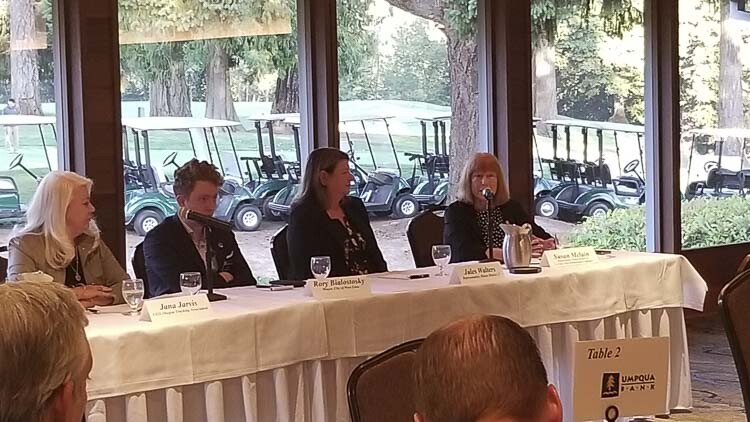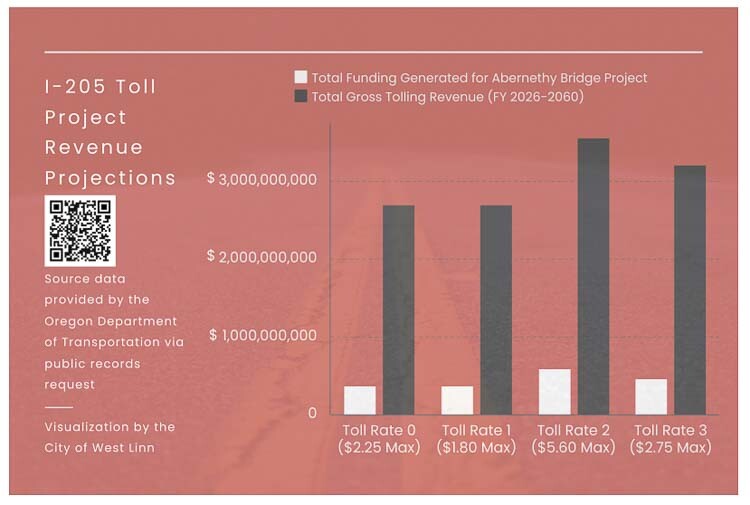Tolling plan will take over $2.7 billion from people to raise $400 million
John Ley
for Clark County Today
The Oregon Department of Transportation (ODOT) is short of money – billions short. In 2017 the Oregon State Legislature authorized the study of tolling in HB 2017 as a possible new source of money for transportation.. Four years later, lawmakers authorized the collection of tolls in HB 3055. Last year, Governor Tina Koteck issued an executive order pausing the collection of tolls until January 2026 because of significant citizen pushback.
The Regional Tolling Advisory Committee (RTAC) has been meeting to consider impacts on tolling around the Portland metro area. Two different tolling proposals are under consideration. One to pay for the I-205 Abernethy Bridge and I-5 Rose Quarter projects. The other is a “per mile” charge for all Portland area highways and freeways, in the Regional Mobility Pricing Project.
Pushback on tolling has been especially significant in Clackamas County where tolling is scheduled to be implemented first. Officials from local cities and the Clackamas County Commission know there will be huge traffic diversion as a result of people trying to avoid paying tolls. Some scenarios indicate the number of vehicles using side roads will double on roads that are already congested.

This is especially important to the 75,000 Clark County residents who work in Oregon and commute to work. It would also impact Southwest Washington businesses who regularly cross the river. Additionally, tolling the Interstate Replacement Bridge is tentatively scheduled to be handled by ODOT, which has no current expertise in tolling.
West Linn Mayor Rory Biolostosky is a member of RTAC, fighting to get information about numerous aspects of tolling. He participated in a September community forum on tolling. When ODOT wasn’t candid about information at the November RTAC meeting about revenues available and the cost of collecting those tolls, he filed a public records request. The data provided by ODOT and their WSP consultants is stunning to many.
The cost to collect tolls under the present set of scenarios runs from 83 to 86 percent. “The first six trips, all your tolls pay for overhead,” Bialostosky said in an interview with Oregon Tolling Updates. “Only the seventh trip pays for borrowed money,” to fund the Abernethy bridge.
Bialostosky shared his shocking findings with a subcommittee of the Oregon Legislature. The Oregon Legislature’s Joint Special Subcommittee on Transportation Planning met at Gladstone High School on Saturday and took public comment.
“Financial documents show that to raise between $369 million and $572 million for the bridge project, ODOT will need to generate between $2.7 billion and $3.5 billion in tolling revenue,” Bialostosky said. There were four toll rate scenarios studied. Tolls ranged from $1.80 to $5.60.
“Basically, $7 in tolling revenue is paid by road users for every $1 in bridge funding generated,” he said. Originally, phase one of the I-205 project not only expanded the Abernethy Bridge from two lanes to three lanes, but did a seismic upgrade. Phase two was adding a new third lane to I-205 for seven miles between the bridge and Stafford Rd. The added vehicle capacity was going to eliminate 12 hours of traffic congestion, according to ODOT.
The second phase is now on hold because ODOT is running out of money. This is in spite of the state receiving record amounts of federal funding from the $1.2 trillion Infrastructure Investment and Jobs Act (IIJA). It has been estimated there is a $3 billion funding shortfall, and that doesn’t count Oregon’s obligation for the Interstate Bridge Replacement (IBR) project.
Biolostosky asked the question – “who benefits from tolling?” The records he received shows that the out-of-state vendor selected to run the Customer Service Center on behalf of ODOT will reap $400 million to $530 million. The operating costs of the tolling system will be between $1 billion and $1.2 billion, excluding set up.
“When the consultant fees and Customer Service Center costs are paid, those two items will far exceed the funding generated for the bridge project,” he said.

ODOT does not have current experience with tolling. Washington state has five separate tolling facilities, all in the Puget Sound. During the pandemic lockdowns imposed by Gov. Jay Inslee, tolling revenues fell off a cliff. The Washington State Legislature had to bail out the tolling facilities with general fund money.
Recent reports from the Washington State Transportation Commission indicate the SR-99 tunnel in downtown Seattle is permanently underwater and will never be able to fully pay off borrowed money. The I-405/SR-167 tolling system had a cost of collection of 68 percent in 2020..
The WSTC is now considering raising the minimum I-405 toll from $10 one way to $18. Furthermore, they are considering creating three separate zones, meaning a person could pay $54 for a one way trip through all three zones if implemented.
In remarks submitted in advance to the Oregon committee, citizen Paul Edgar noted that a 2 cent gas tax for 10 years would raise $500 million, in essence delivering more than three of the four tolling scenarios. The gas tax has less than a 1 percent cost of collection. He expressed concerns that the traffic diversion would result in increased vehicle accidents and deaths.
Bernard Black, manager, Black’s Pest Services LLC told the committee that tolling costs for commercial businesses like his would be passed on to customers, adding to inflationary pressures on average citizens. “Oregon is already a fairly high tax state,” he said..Black prefers the legislature find other sources of money to pay for roads. He also favors letting citizens vote on tolling.
Presently, Oregon citizens are collecting signatures for IP-4. It would guarantee a vote before tolls can be placed on any Oregon freeway or highway. It is retroactive to 2017 and would impact all current projects. They have until the end of June to collect 200,000 signatures.
West Linn resident Shannen Knight was a member of ODOT’s Statewide Tolling Rulemaking Advisory Committee (STRAC). She noted that Portland residents want the tolls, but no lanes added to area highways or freeways. All other area residents prefer just the opposite. “Those who live in the suburbs don’t want tolling at all, but they do want the third lane of I-205 to be built,” she said.
Knight noted that ODOT officials do a great deal of public outreach, but they are ignoring people’s input. “This is not what I would call ‘involving’ the public,” she said. “Involving means that the public is shaping their plans. It is clear from the testimony and my role on STRAC that the public is not ‘involved’ but rather just being kept “informed” on how, when and where.”
“ODOT continues to do the opposite of what the public has asked for.,” Knight concluded. She noted that in most parts of Portland people have alternatives to avoid tolling. That is not the case for Oregon City and many Clackamas County residents.
Amy Ingham expressed frustration with ODOT. She and many citizens had asked questions about traffic diversion impacts and the reduced quality of life in neighborhoods. “Zero answers from ODOT,” she told the committee, over and over. :”Where is the accountability for the funds already spent,” she asked. Ingham believes the tolls would cost her $3,000 per year and would be a significant financial hit.
“The existing ODOT tolling plan is inequitable, one-sided, and unworkable,” said Matt Brown of West Linn.
Richard Hiatt of Scappoose noted that far too much money has been wasted on mass transit and bicycle infrastructure, rather than keeping roads and bridges safe and reducing congestion. “People want the ability to freely travel,” Hiatt said.
Biolostosky summed it up for the community. “The first glimpse of tolling financials are stunningly bad, and despite knowing this, ODOT is moving full steam ahead,” Bialostosky said. “ODOT wants to rush the start of tolling and lock in financing, no matter what the cost to Oregonians. They justify this by saying that this is what the legislature intended.”
Also read:
- Expect delays on eastbound SR 14 West Camas Slough Bridge for annual inspection, SaturdayAnnual inspection will close the eastbound lane of SR 14 in Camas.
- C-TRAN seeks public’s input on September 2025 Service Change ConceptsC-TRAN is gathering public input on 2025 service changes, including new routes and expanding its on-demand ride-share, The Current.
- Expect delays on eastbound SR 14 for safety repairs, April 2Expect delays April 2 on eastbound SR 14 for guardrail repairs near Camas.
- Belkot files suit against Clark County, alleging civil rights violations, breaches to open meeting lawsClark County Councilor Michelle Belkot claims she was removed from the C-TRAN Board of Directors after she intended to vote to protect taxpayers Clark County Councilor Michelle Belkot filed a lawsuit in Skamania County Superior Court against Clark County on Friday, citing violations of the Civil Rights Act, Open Public Meetings Act, and Quo Warranto …
- Clark County hosting April 10 open house about the Northeast Delfel Road realignment projectClark County to host April 10 open house on Delfel Road project, replacing signals with a roundabout.










What would the Shark Tank crew say???
“WSTC is now considering raising the minimum I-405 toll from $10 one way to $18. Furthermore, they are considering creating three separate zones, meaning a person could pay $54 for a one way trip through all three zones if implemented.”
“The cost to collect tolls under the present set of scenarios runs from 83 to 86 percent.”
” a 2 cent gas tax for 10 years would raise $500 million, in essence delivering more than three of the four tolling scenarios.”
Clearly a gas tax is a better way to raise $.
Seems like the out of state tolling companies who stand to make a fortune are the ones who will benefit at the expense of road users including freight in both WA and OR.
We need legislators whose top priority is to keep our economy , and residents working. Roads are the lifeblood of our communities.
For Oregonians, https://votebeforetolls.org/
…. Can’t even imagine the traffic jam-ups on surface streets as motorists seek to avoid the tolls. 🤡
Can Odot do anything except more boondoggle? 🙄
This is the agency that thought blowing up a whale was a good idea, so set your expectations accordingly.